- Home
- George Zebrowski
Macrolife Page 2
Macrolife Read online
Page 2
The Bulerite calamity renders the Earth dramatically uninhabitable. Earth’s very crust is cracked, recriminations trigger an all-out nuclear war, and to trump the doom the Earth and Moon are engulfed in a bizarre, other-dimensional bubble. At first glance this may seem a rather histrionic and arbitrary plot device to compel macrolife to set out on its journey of growth; almost a deus ex machina at the very outset of the novel. If it requires such a far-out set of circumstances to launch macrolife, then macrolife cannot be such an inevitable future, can it? Could it be, also, that Zebrowski deliberately lays on the apocalyptic action with a trowel so as to refresh the reader after some rather lengthy and serious philosophical conversations in Platonic dialogue mode?
A problem of substance? And a problem of style?
Zebrowski’s concern with rebirth from out of cataclysm reflects his own background as a member of a mutilated nation. “I feel the force of memory that pushes out from my parents,” he has written; “it’s always there, a shadow cast by a world gone insane.” His past was “brutal, cruel, and stupid…created by people…who didn’t want me to be born.” Dirtworlds are also brutal, cruel, and stupid as environments; and the escape to a space habitat, which is free from the shocks to which planetary flesh is heir, may be emotionally patterned upon Zebrowski’s own escape as a child from war-torn Europe to America. This, plus a subsequent pattern, which segued with his discovery of science fiction. For though he was an adoptive New Yorker, a temporary move to Florida from the gang-haunted, refugee-packed, decaying South Bronx presented him with warmth, cleanliness, light, and a white marble public library, “a place out of Clarke’s Against the Fall of Night” (or something in the meadows of a macroworld) where he discovered endless shelves of early hardback volumes from Fantasy Press, Gnome Press, Shasta, and Doubleday.
Thus there is an emotional pattern in Zebrowski, of salvation from apocalypse—not for everyone but only for the fortunate ones. There is an intellectual argument, too. The Bulerite disaster is appropriate because it is an example (this particular one mixing natural calamity with human folly) of a whole range of disasters that can very easily overtake natural planetary life when all the eggs are in one basket. The very escape route from ravaged Earth—aboard the hollowed asteroid, Asterome—is a reminder of another possible disaster that was narrowly averted. Until diverted and moored at a libration point in the Earth-Moon system, this same asteroid had once been on a collision course with Earth. Nothing in our present day prevents a similar asteroid or comet from impacting with our planet at any time, as has happened repeatedly during geological history. Such an impact, releasing the equivalent power of thousands of hydrogen bombs, would destroy civilization and probably cause a mass extinction of species, our own included. A planet-bound culture is also threatened by any instability in its sun, by the climate flipping into a new ice age, and it is challenged by its own success in the form of chemical and thermal pollution, as witnessed by the ozone holes and global warming.
At the moment we only have one single planetary egg with only a finite amount of nourishing yolk in the shape of resources, and only a finite ability to tolerate the stresses of the growing chicken of civilization within itself before it cracks wide open, killing the chicken because nowhere else is available. The crack in the Earth’s crust is a telling symbol. Likewise is Bulerite, that super-strong substance that allows lattice-cities to be built and the Empire State Building to disappear underneath layers of new New York.
Bulerite seems to strengthen the frail shell of the egg. But this proves untrue. Bulerite is unstable and highly destructive when it releases its locked-up energies. Its exploitation by eager capitalism, which neglects to pursue the fundamental research work of its discoverer, is a complacent strategy, and complacent strategies are potentially lethal ones.
Bulerite will find its rightful uses later on, in connection with other scientific advances that permit space-warp travel. Thereby it is further integrated into this well-designed, cleanly dovetailed book, not only as an instance of the false buttressing of the frail shell that is the Earth, but also as an appropriate example of future science—in this case, exotic states of matter and their applications.
Zebrowski does not allow his free-enterprise Bulero family simply to build higher and higher until they reach the stars. What sets macrolife on course is the failure by those exploiters of the wonder substance fully to investigate it, in other words their treachery. Through the trauma of their “crime” the Buleros are able to liberate themselves and a segment of the human race, leaving the solar system behind. A realist ever, Zebrowski acknowledges that even a millennium later the Buleros would be viewed by many people as renegades. The dramatic argument is a complex one, with no simple black versus white.
Nor are there easy black/white solutions to the possible sociological problems of space habitations. In various permutations Zebrowski explores not only the inevitable conflicts of interest between planetary and nonplanetary dwellers but also the unavoidable conflicts within a macroworld itself, which must somehow be channeled so that internal rebellion expresses itself as reproduction by consent. This was all some way removed from the rose-tinted optimism of many advocates of space colonies with their vision of geriatric joggers happily trotting around the bent meadows of the profitable paradise in the sky, at L-5, where everyone is blissfully of accord.
And a problem of style?
Zebrowski has remarked that Macrolife is a meditative book and should be read meditatively. Space stations may explode, cities may collapse, the Earth itself may convulse; however, the prose is meditative, just as the long-lived inhabitants of a future macroworld would be. “Their minds are still, waiting for every ripple of space-time to register,” Zebrowski has commented. We are mayflies now, but they are not. Despite scenes of action and even violence, and notwithstanding limpidly beautiful descriptions, this is a book of thought, its pages turning with a measured sureness. For Zebrowski, the ideal reader is a “performer,” not a “slave.” Himself a child of slaves whose Nazi masters wished to stamp their ideology upon the face of Europe, Zebrowski perhaps detects an analogy with those addicts of junk SF who expect an author to insert a cassette of thrills into their heads. For the performing reader, by contrast, “the novel is a series of opportunities for thought, understanding, and empathy.”
Macrolife is an excellent novel to perform with.
Stylistically, much of the time a solemn, neutral mode of speech prevails. People don’t swear or crack jokes or use slang. This isn’t so much because a lot of the conversation is expository as simply that this is the chosen tone (with emphatics provided by occasional, italicized internal dialogue). Reviewers criticized the novelist Morris West for his neutral-sounding dialogue, to which West replied in an interview with a British newspaper some years ago: “Listen, love, it is all deliberate. My dialogue is sedulously designed, not as real speech but as a cerebral vehicle for ideas in the novel. I want dialogue to be understood at once in every Anglo-Saxon country and to translate easily into the major European languages…. I elected this style.”
Likewise with Zebrowski. Yet there is a further reason beyond the aspiration to an international (and even interstellar) style. This crops up in miniature early on when three of the characters discuss macrolife over a Chinese meal and a bottle of brandy. One of them, Sam, fades out of the discussion. Afterward: “‘…I hope you followed some of what we said.’ ‘I really did, Orton. Inside I’m sober, really.’ How can frail beings like us think of doing the things Richard and Orton described?” Certainly somebody can drift off into a brandy haze, yet in most novels they would become tipsily involved in the discussion. Sam does end up knocking over the brandy bottle, yet he never knocks over the conversation. The point is that our irrational heritage from the evolutionary jungle of rape and murder—“nature’s agriculture of death”—must be opposed by rational intelligence if we are to survive and transcend ourselves. The style of Macrolife reflects its firm adherence to reason and
to the power of rational persuasion.
It isn’t the case that it would be vulgar to have the characters joking, swearing, and “slanging” each other. Rather, the mood of the dialogue is the mood of the book’s deepest beliefs, beliefs that are sincerely held rather than merely being adopted as a pretext to write a momentarily vivid but forgettable yarn.
Much trivia occurs in novels, a lot of it concerned with so-called character-building. Zebrowski’s characters aren’t flat; they are complex and imperfect, especially John Bulero in Part 2, no superhero but a study in failure who manages in the end to transcend his somewhat self-indulgent angst. Yet trivia as such are absent. Perhaps this reflects Zebrowski’s relations as a child with his own parents. The Nazi war, and the sufferings of his parents and his people, “cast its shadow over everything,” he confesses, “preventing my problems from just being my own. I had no right to have lesser problems.” Personal trivia were as nothing.
In Part 2, “Macrolife: 3000,” the cloned John Bulero is an old-style human being among a space-faring community of genetically enhanced specimens of humanity-plus—who link with the presiding artificial intelligence and are now part way toward the larger mind-fusion to come. John’s compulsive, if shy, adventuring upon the dirt-world Lea, which becomes increasingly bound up with his own erotic mesmerism by the planet-born young woman Anulka, comes to grief finally through failure of forethought on his part followed by a failure of rationality. Being ruled by the old drives—such as plain savage revenge and the habit of pulling the wool over one’s eyes—John may seem in some respects a more “real” character than others who are genetically akin to him in the “Sunspace: 2021” section. Yet he is, in fact, exactly as they were. It is only by comparison with the transhu-mans now surrounding him that he seems more familiar to us. This is actually an illusion, a product of our mesmerism by the old emotional drives and of our consequent expectations as to how “real” characters ought to behave, namely, to fly into rages, to sulk, to fight, to agonize, to act irrationally. Just as the personal must eventually be superseded and integrated, so “personalities” should not be valued too grossly.
At the same time, John’s errors—and the errors represented by the dirtworld—forcefully illustrate an important fact about evolution in any species, namely, that individuals and species alike must not aspire to a wholly perfect state where they can no longer make errors from which to learn.
Macrolife first appeared in 1979. Just over a decade earlier another believer in the transmutation of humanity, Alexei Panshin, won a
Nebula Award for his novel Rite of Passage, detailing the twenty-seven-thousand-strong society of another macroworld, an asteroid starship commuting around the dirtworlds that were seeded before nuclear cataclysm destroyed the Earth due to overpressure in the egg. Zebrowski’s “factual” sources for Macrolife were such as J. D. Bernal and Dandridge Cole, but it’s illuminating to examine the fictional evolution of the idea between Rite of Passage and the later book.
Panshin’s society, like that of Zebrowski’s original Asterome, is a two-tiered democracy with an executive council and the option of universal plebiscites. However, Panshin’s macroworlders are quite rigidly conservative and opposed to change, and a power ethic prevails. In Macrolife, when the UN commander Nakamura attempts a coup to seize control and force Asterome to remain in the solar system to aid in reconstruction, we witness the misuse of conservative power. The moral is that conscious life must be willing to take giant risks, to engage in acts of wild faith such as the departure of Asterome and the consequent birth of macrolife.
Zebrowski adds spacious shells to the argument, just as Asterome itself builds shell upon shell of additional space. Panshin’s macroworld remains a rock with the hard ideology of a rock. Thus its own population must be culled in Darwinian fashion by the rites of passage of the title: the dumping of well-prepared youngsters upon dirtworlds to see whether they can survive the experience. Many do not survive, to a large extent on account of the hatred and contempt of the “mudeaters,” locked up on their hardship worlds, for the privileged star-commuters who control the void-spanning hives of human knowledge, wealth, and skill. Heroine Mia is helped to survive by an old radical of a mudeater who opens her eyes somewhat, though it is to a fellow macroworlder that she opens her legs on the planet, by contrast with John Bulero’s sexual infatuation for a native. In the end the whole world of Tintera is destroyed by the peeved macroworlders, who have lost more juniors than desired during the rite of passage there.
Zebrowski’s macrolifers do hate the past and what a dirtworld stands for—a chain upon the human spirit—but they are by no means so dogmatic, and John’s voluntary rite of passage upon the surface is at once more lightly undertaken and more ambiguous in its lessons. The macrolifers wish to be neither philanthropists nor destroyers of worlds. The attitude they aspire to is one of empathy without overt altruism. Life must remain open-ended, all possibilities available. The macrolifers aspire to immortality—to life beyond life—whereas Panshin’s elite merely live longer lives than ours, and basically their society and their mind-set are closed. Certainly Zebrowski’s macrolifers do not inhabit a perfect Utopia. Boredom and suicide are rather too common for comfort. However, there is enough challenge to shake them up and spur them to continue on the royal road toward multivalent, cosmic intelligence.
In the third section of Zebrowski’s novel, “The Dream of Time,” macrolife must reconjugate the unmodified John Bulero from out of the collective higher mentality of which he has become part, because by this late date only such as he can decide on the error-liable risk of trying to survive the collapse of the universe through into the next cycle. Like the original founders of macrolife, he can make a blind decision of transcendent potential.
Bound up with this essential feature of the importance of error and of the capacity for error is the strange fact that the universe is both capable of being known yet eludes being known in its entirety. The universe possesses a built-in incompleteness. Were it wholly knowable, thought and life would become static. Consequently, those macrolifers who survive the collapse of the cosmos at last meet earlier, wiser macrolifers from a previous cycle of creation who suspect, for their part, that even higher, earlier entities exist. There are shells beyond shells.
If this is the case, surely macrolife must already exist in our universe. Surely the universe today must be teeming with macrolife. Why, then, is there no sign of it? When human macrolife first encounters alien macrolife in Part 2 of the novel, that more mature civilization is already a million years old, adept at concealment until it chooses to reveal itself. In cosmic terms, even a million-year-old civilization is almost contemporary with us. As human and alien macrolife fuse and evolve, so do the old suns burn out and so are new stars formed, with new planets where new life-forms can arise and in their turn develop intelligence, master space, and give rise to new macrolife. Our universe is very large, and time is long. Successive hierarchies, shells, are possible. This may equally be true of the succession of universes themselves.
This final, remarkable section—with its dialogue between the reconjugated ancient man and metalife falling apart under stress, with its triumph over time—is the most moving, sustained, and poetic sequence in the novel (always with a lucid poetry). It opens up whole cycles of possibility, just as the hundred-billion-year “gap” in the book’s chronology leaves riches yet to be explored in subsequent, varied macrolife novels that Zebrowski plans.
Cave of Stars appeared in 1999, a fascinating and deeply thoughtful account of a giant habitat’s fatal encounter with a dirtworld. Actually, to say “giant” belies the reality, since a habitat a hundred kilometres long, constructed of concentric shells around an original asteroid core, contains more internal space than the entire surface of a planet, space enough for numerous alternative worlds such as an entire sea-world especially tailored for adapted humans with gills who have opted for an aquatic existence.
Other citizens exercise thei
r freedom of choice by entering virtual realities; or they may need to enter these temporarily for medical reasons. Whichever the case, VR tends to become addictive, posing a subtle threat to such a habitat, namely, that not enough citizens may remain in the real world to continue guiding its destiny and make vital choices. Lotus-eating and virtual adventures may occupy all their attention. Indeed, certain philosophers aboard this particular habitat speculate that it in itself may be a virtual reality, a sophistical argument soon refuted by events—with all the brusqueness of Dr. Johnson kicking a big stone to refute by demonstration Bishop Berkeley’s notion of the nonexistence of matter. Overconfidence in superior technology makes this habitat vulnerable to destruction by one bigoted dirtworlder, who also holds keys of power, for he is the pope of a conservative Catholic Church which has survived upon that world, determined to prevent progress.
Arthur Clarke has variously observed that religion is a form of psychopathology—a neurological disorder—that within a few centuries from now all the old religions will accordingly have been discredited, and that civilization and religion are incompatible. In this sense a disciple of Clarke, Zebrowski destroys the last redoubt of Catholicism in spectacular fashion in Cave of Stars, although not before the last pope has committed an ultimate atrocity.
Cave of Stars contains a neat definition of what macrolife is: “a mobile…organism comprised of human and human-derived intelligences. It’s an organism because it reproduces, with its human and other elements, moves and reacts on the scale of the Galaxy.” It is larger inside “than the surface of a planet. And larger still within its minds.”

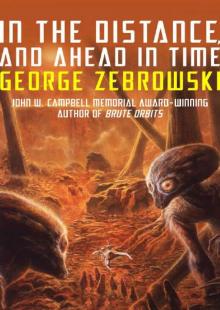 In the Distance, and Ahead in Time
In the Distance, and Ahead in Time Stranger Suns
Stranger Suns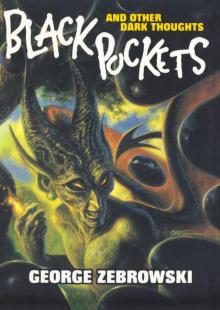 Black Pockets
Black Pockets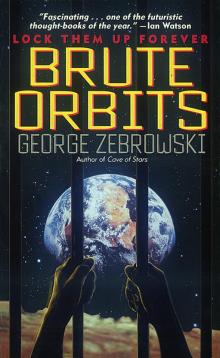 Brute Orbits
Brute Orbits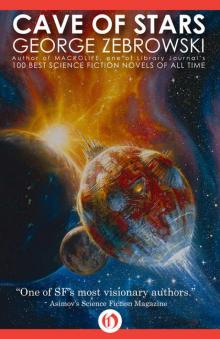 Cave of Stars (Macrolife Book 2)
Cave of Stars (Macrolife Book 2) Macrolife
Macrolife Empties
Empties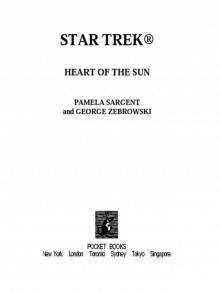 Heart Of The Sun Star Trek 83
Heart Of The Sun Star Trek 83 The Sunspacers Trilogy
The Sunspacers Trilogy